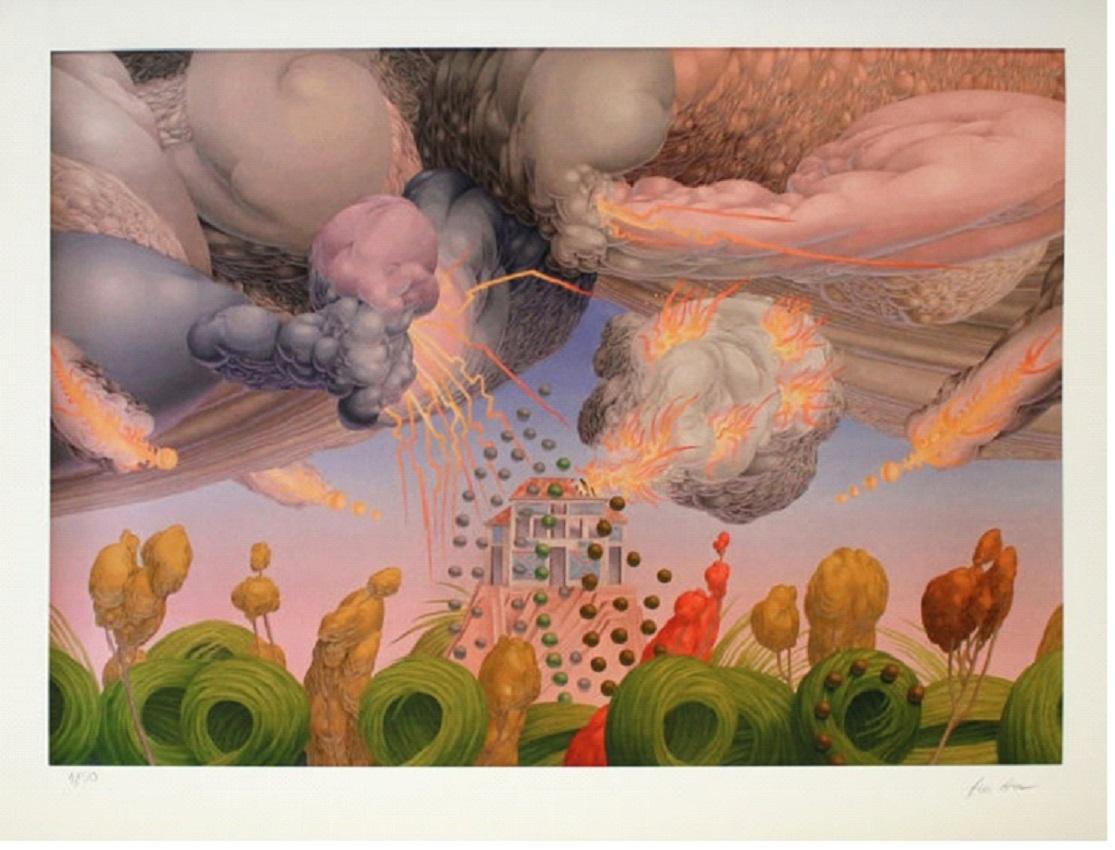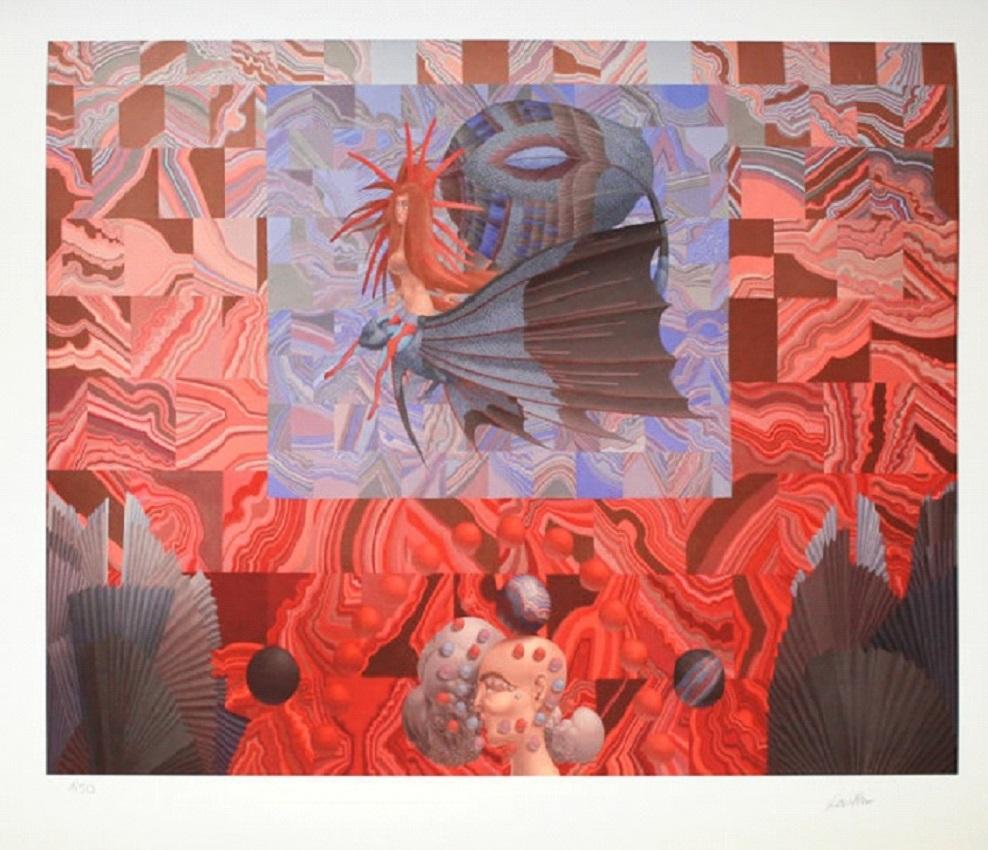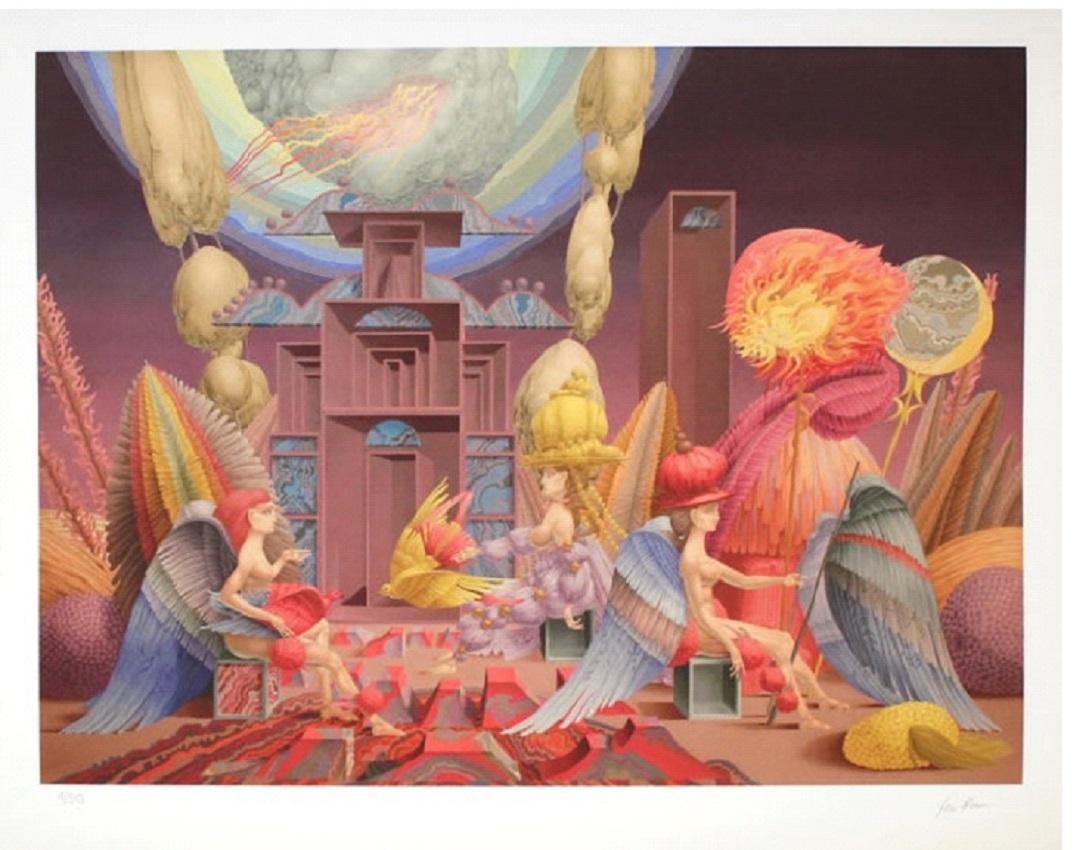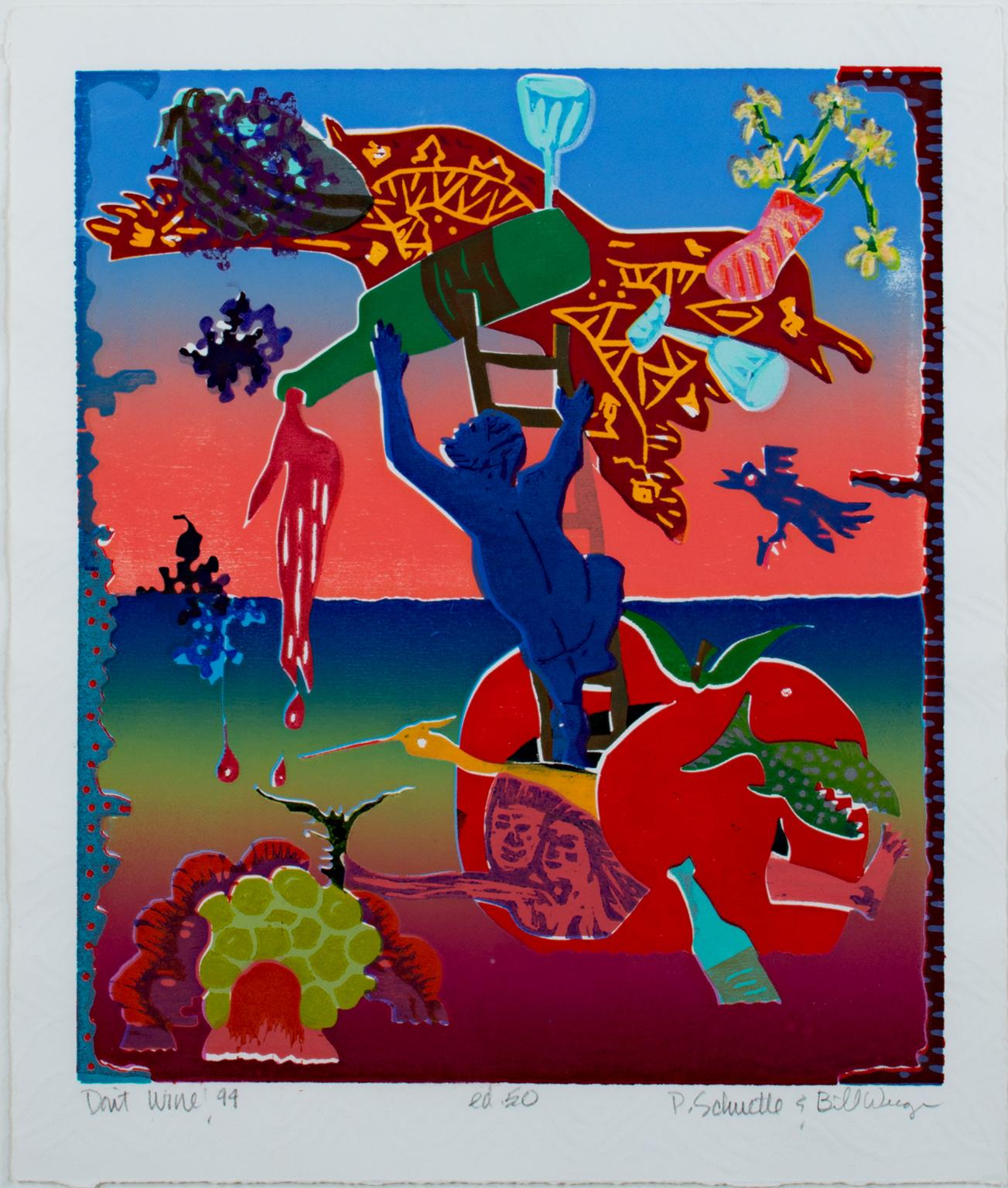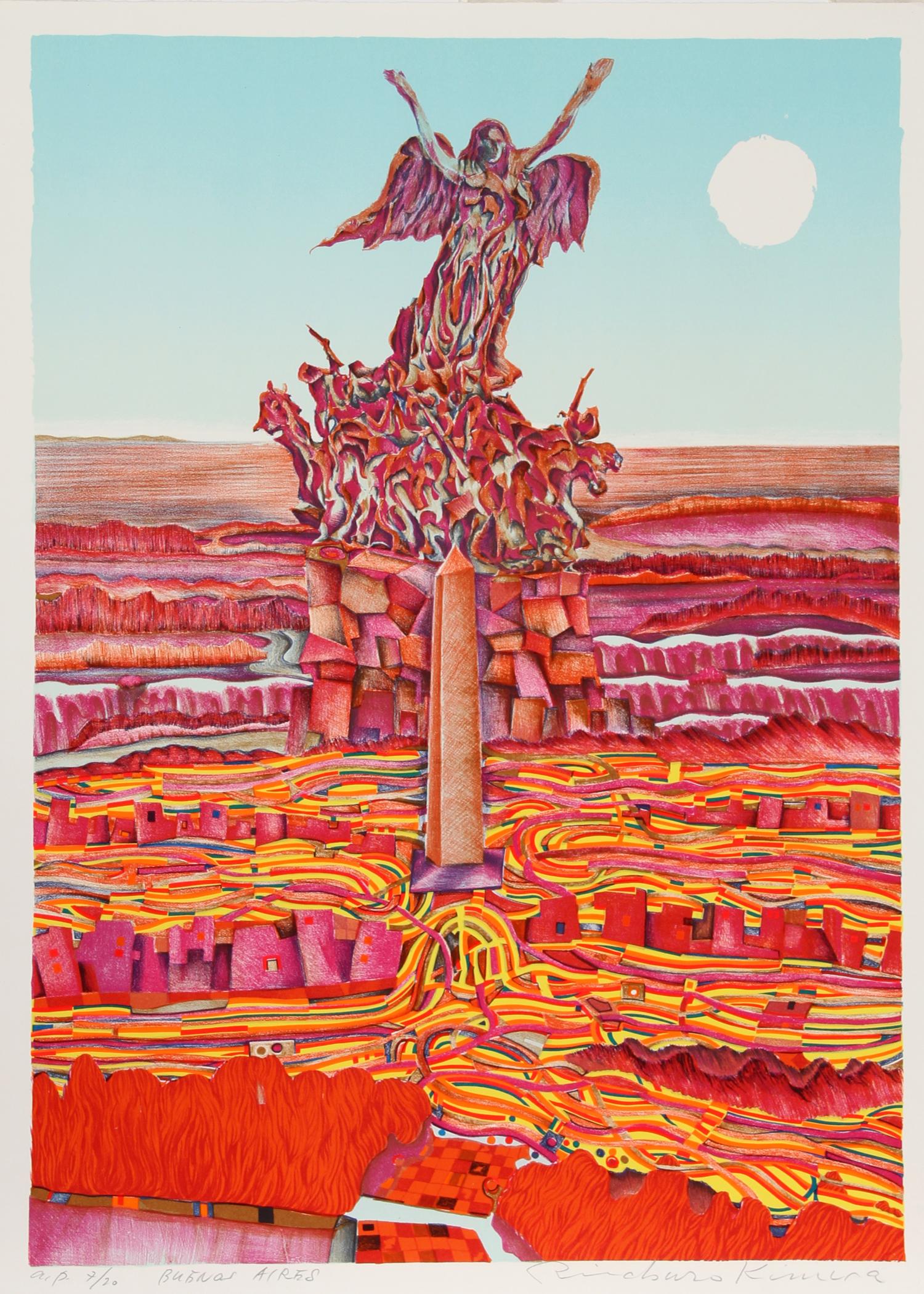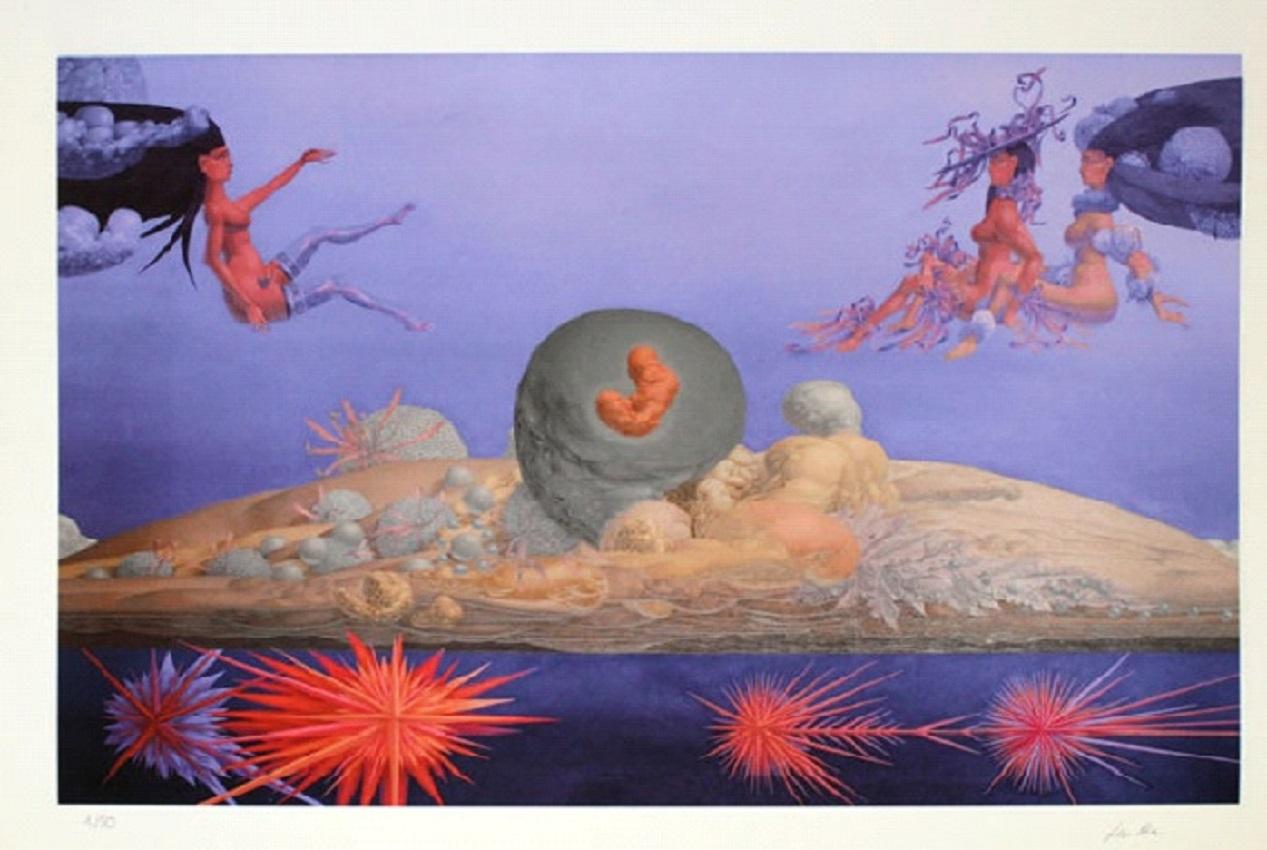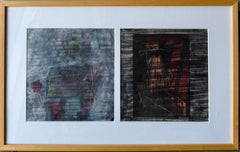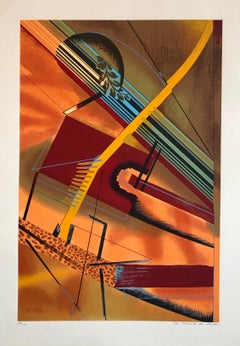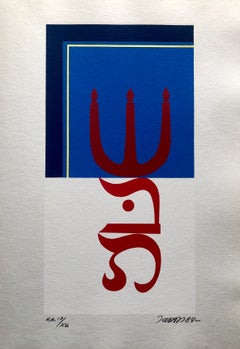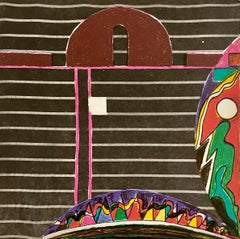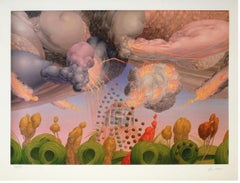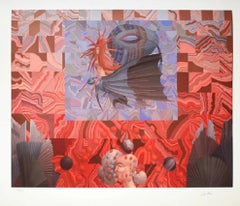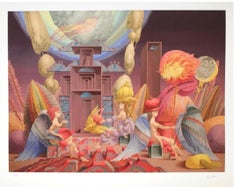Items Similar to Austrian Psychedelic Abstract Fire Tower Water Tower Silkscreen Wolfgang Hutter
Want more images or videos?
Request additional images or videos from the seller
1 of 9
Wolfgang HutterAustrian Psychedelic Abstract Fire Tower Water Tower Silkscreen Wolfgang Hutter1974
1974
$1,400
£1,093.51
€1,239.63
CA$2,007.06
A$2,201.63
CHF 1,151.93
MX$26,203.80
NOK 14,549.55
SEK 13,647.74
DKK 9,258.22
About the Item
Fire Tower Water Tower (1974) Silkscreen Lithograph by Wolfgang Hutter
Wolfgang Hutter (1928 – 2014) was a painter, draughtsman, printmaker and stage designer. Hutter's imagery is characterised by an artificial paradise of gardens and surrealist fantastical fairytale-like scenes. His work is said to have been influenced by his psychedelic experiences.
Hutter was born in Vienna, Austria. With Jewish origins, the son of the artist Albert Paris Gütersloh, Hutter studied at the Academy of Fine Arts in Vienna under Professor Robin C. Andersen and then under his father Together with Ernst Fuchs, Maître Leherb (Helmut Leherb), Rudolf Hausner, Fritz Janschka, Anton Lehmden and Arik Brauer,
In 1946 Rudolf hausner founded a surrealist group together with Edgar Jené Ernst Fuchs, Wolfgang Hutter and Fritz Janschka. They are later joined by Arik Brauer and Anton Lehmden.
He became a founding member of a group of artists who met at the Vienna Art Club, a collective which would later become known as the Viennese School of Fantastic Realists or the Vienna School of Fantastic Realism. Brauer describes the predominant climate of the time as follows: “In the late forties, a belated surrealism was still too modern for Austria." Hutter was awarded the UNESCO Prize at the Venice Biennale in 1954. In 1966, he was appointed a professorship at the University of Applied Arts Vienna. According to Friedensreich Hundertwasser it was
Wolfgang Hutter who discovered him. "Wolfgang Hutter saw at the Christmas exhibition "Good Pictures for Everyone", where it was on sale for 300 schillings, and he nominated me to be a new member of the Art Club, to which I was admitted one year later. It can thus be justifiably said that it was Wolfgang Hutter who was the first to discover me for the world of art". His work blends legend with fantasy in bold acid colors in a colorful outsider art visionary genre.
Bibliography
O. Breicha, Wolfgang Hutter – Werkkatalog, Vienna 1977.
Tatowierung. (Foreword Alfred Schmeller) Verlag Grasl, Baden b. Wien 1965
Berichte aus einer anderen Welt (Introduction Otto Breicha) Waldheim-Eberle Verlagshaus, Wien 1967
Auflage in zwei Bande (1. "Malerei und Zeichnung; Schriften zu "Kunst und Urwelt" (Preface A. P. Gutersloh).
Graphik; "Über sich selbst nachzudenken" (in Conversation with Wolfgang Hutter), Essay und Werkkatalog Otto Breicha. Verlag Jugend und Volk, Wien— München 1977
Zauberflote (Monographie über das gleichnamige Portfolio, mit einem beigelegten Text "Zur Zauberflöte" von Wolfgang Hutter), Euro-Art-Bucherkreis GmbH, Wien 1974
Feder Menschen (with an introduction by Wolfgang Hutter) (Self-published.)
References
Steven Beller, Vienna and the Jews, 1867–1938: A Cultural History, Cambridge University Press (1990)
About the Seller
4.9
Platinum Seller
Premium sellers with a 4.7+ rating and 24-hour response times
Established in 1995
1stDibs seller since 2014
1,836 sales on 1stDibs
Typical response time: 1 hour
- ShippingRetrieving quote...Shipping from: Surfside, FL
- Return Policy
More From This Seller
View AllBay Area Figurative Abstract Gouache Painting "Video Tower" John Hultberg
By John Hultberg
Located in Surfside, FL
John Hultberg (1922-2005)
Gouache (mixed media )
"Video Tower"
1991
Hand initialed lower right
Measurements: 18.75" W x 11.75" H (framed); 6.75" W x 7.25" H (visible area of each ...
Category
1990s Abstract Abstract Paintings
Materials
Gouache, Mixed Media
Surrealist Architectural Landscape Silkscreen 1970s Chicago Modernist Lithograph
By William Schwedler
Located in Surfside, FL
Orange, Turquoise, Red, Surrealist abstract.
This serigraph has never been framed. It is pencil signed by hand "the estate of Wm Schwedler" and numbered in pencil from the limited ed...
Category
1970s American Modern Abstract Prints
Materials
Screen
Surrealist Abstract Hebrew Shabbat Pop Art Silkscreen Judaica Jewish Serigraph
By Jozsef Jakovits
Located in Surfside, FL
Abstract Hebrew Prints on heavy mould made paper from small edition of 15. there is a facing page of text in Hungarian folded over. Hard edged geometric abstract prints in color base...
Category
1980s Pop Art Abstract Prints
Materials
Archival Paper, Screen
Feminist Surrealist French Abstract Colorful Lithograph Print Myriam Bat Yosef
Located in Surfside, FL
Myriam Bat-Yosef
Surrealist abstract lithograph print in colorful abstract shapes and shades
Hand signed and dated 1971.
sheet measures 9.25 X 9.25 inches
The envelope and the Peter Buch poster is just for provenance and is not included in this sale.
Myriam Bat-Yosef, whose real name is Marion Hellerman, born on January 31, 1931 in Berlin, Germany to a Jewish family from Lithuania, she is an Israeli-Icelandic artist who paints on papers, paintings, fabrics, objects and human beings for performances. Myriam Bat-Yosef currently lives and works in Paris. In 1933, her family fleeing the Nazi Holocaust, Miriam Bat-Yosef emigrates to Palestine and settles in Jaffa. In 1936, she suffers a family tragedy, her father, militant Zionist, is called to fight, still recovering from an operation of appendicitis. The incision will become infected, antibiotics did not exist yet, and her father will die in the hospital after 9 months of suffering.
Myriam and her mother leave Palestine to live in Paris for three years. French is Myriam's first school language. In 1939, still fleeing Nazism, she returned to Palestine, leaving France by the last boat from Marseille. She moved to Tel Aviv with her mother, aunt and maternal grandmother.
In 1940, she began attending the Academy of Fine Arts in Tel Aviv and took her name as an artist, Bat-Yosef, which means Joseph's daughter in Hebrew, as a tribute to her father. In 1946, Myriam graduated as a kindergarten teacher but wanted to be an artist. Her mother enrolled her in an evening school to prepare a diploma of art teacher. At 19, she performs two years of military service in Israel.
In 1952, with a pension of $50 a month that her mother allocated, she went to study at the Beaux-Arts in Paris. To survive, she has several activities while studying. In 1955, she had her first solo exhibition, at the Israeli Club on Wagram Avenue in Paris. Many artists, such as Yaacov Agam, Yehuda Neiman Avigdor Arikha, Raffi Kaiser, Dani Karavan and sculptors Achiam and Shlomo Selinger attended the opening .
In 1956, she enrolled at the School of Fine Arts in Florence. This is where she meets the painter Errô. They share an icy studio in winter. Myriam moves to Milan with friends. She organizes a joint exhibition with Erro, one room each, at the Montenapoleone gallery. Her works are admired by the sculptor Marino Marini and the painters Renato Birolli and Enrico Prampolini. Myriam and Erro exhibit in Rome, Milan, Florence and meet many personalities: Alain Jouffroy and his wife, the painter Manina, Roberto Matta and his wife Malitte, textile artist who was one of the founders of the Pompidou Center. Back in Paris, Myriam and Erro get married, which allows Myriam to avoid being called into the Israeli army during the Suez Canal War.
In 1957, Myriam and her husband went to Iceland. Myriam works in a chocolate factory. Having enough money, she starts producing art again. She exhibited in Reykjavik's first art gallery. She meets the artist Sigridur Bjornsdottir, married to the Swiss painter Dieter Roth .
In 1958, Myriam and her husband leave for Israel. They exhibit in Germany, then in Israel. Back in Paris, the couple became friends with artists of the surrealist movement, such as Victor Brauner, Hans Bellmer, the sculptor Philippe Hiquily, Liliane Lijn, future wife of Takis and photographer Nathalie Waag. Erro and Myriam have a daughter on March 15, 1960, named Tura, after the painter Cosmè Tura, but also close to the Icelandic Thora or the Hebrew Torah. Bat-Yosef’s complex trajectory throughout the 20th century is linked as much to the transnational history of what was for a time called the School of Paris as it is to a certain legacy of Surrealism. Her work features the same idea of resolving antinomies that also defined the spirit of surrealism, and is enhanced with her readings of the Kabbalah and her spiritual grounding in Taoism. However, while there are reasons for her approach to be associated with the process of the ready-made, it is important to consider the immediate intrication of these works with her practice of performance, during which the body itself is also painted – a feminist response to Yves Klein’s Anthropometries (1960) and an echo of the happenings which Jean-Jacques Lebel organised at the time in Paris.
In 1963, Erró told Myriam that if she wants to be a painter, she can not be his wife. Myriam chose to be a painter and the couple divorced in 1964. Since that time, Myriam Bat-Yosef has exhibited in many countries: Europe, United States, Japan, etc.
Although long in the shadows, the work of Myriam Bat-Yosef has been greeted by many artists and personalities: Anaïs Nin, Nancy Huston, André Pieyre of Mandiargues, José Pierre, René de Solier , Jacques Lacarrière, Alain Bosquet, Pierre Restany, Sarane Alexandrian and Surrealist André Breton who, after a visit to her studio, confided to having been intrigued by its phantasmagorical dimension. She was included in the book Pop Art and Beyond: Gender, Race, and Class in the Global Sixties by Mona Hadler and Kalliopi Minioudaki. Extract "World Citizen, Artist of the Pop Era Sarah Wilson; Why do we know so little of Myriam Bat-Yosef, the most important female Israeli artist of the Pop era? Issues of identity and sexuality feature constantly in her work. She exhibited internationally from Reykjavik to Tokyo; she had two shows at Arturo Schwarz’s famous Dada/surrealist gallery in Milan; she participated in feminist art events in Los Angeles. Above all, in 1971, she conceived Total Art, a Pop Gesamtkunstwerk inside and outside the Israel Museum, Jerusalem. Painter, performer, and installation artist, she was also a lover, wife, and mother. Of Lithuanian-Jewish descent, she was close to the family of philosopher Emmanuel Levinas. An émigré in Paris she would repudiate a national passport, participating in Garry Davis’s short-lived “World Citizens” movement. She continues the lineage of women surrealist artists: Valentine Hugo, Leonor Fini, Dorothea Tanning, Leonora Carrington, Unica Zürn, Jane Graverol, Toyen, Alice Rahon...
Category
1970s Surrealist Abstract Prints
Materials
Lithograph
Large Abstract Vibrant Colorful Silkscreen Serigraph Print Japanese Garden
By Tom Baldwin
Located in Surfside, FL
Recently graduated from Pasadena’s legendary Art Center College of Design, Tom Baldwin created the series of inkjet prints Japanese Gardens in 1996 on his computer, using then-nascen...
Category
1990s Abstract Abstract Prints
Materials
Inkjet, Screen
Feminist Surrealist French Abstract Colorful Lithograph Print Myriam Bat Yosef
Located in Surfside, FL
Myriam Bat-Yosef
Surrealist abstract lithograph print in colorful abstract shapes and shades
Hand signed and dated 1971.
sheet measures 9.25 X 9.25 inches
...
Category
1970s Surrealist Abstract Prints
Materials
Lithograph
You May Also Like
Wolfgang Hutter - "The garden and the burning house" - giclée print - labelled
By Wolfgang Hutter 1
Located in Winterswijk, NL
Wolfgang Hutter - "The garden and the burning house".
Giclée print.
Hand signed and numberd.
A beautiful artwork that looks good in every room and e...
Category
21st Century and Contemporary Abstract Prints and Multiples
Materials
Paper, Giclée
Wolfgang Hutter - "The mistress of the dragon and the bald head" - giclée print
By Wolfgang Hutter 1
Located in Winterswijk, NL
Wolfgang Hutter - "The mistress of the dragon and the bald headwith the balls".
Giclée print.
Hand signed and numberd.
A beautiful artwork that look...
Category
21st Century and Contemporary Abstract Prints and Multiples
Materials
Paper, Giclée
Wolfgang Hutter - "The bird, feather, meeting of wings" - giclée print, labelled
By Wolfgang Hutter 1
Located in Winterswijk, NL
Wolfgang Hutter - "The bird, feather, meeting of wings".
Giclée print.
Hand signed and numberd.
A beautiful artwork that looks good in every room an...
Category
21st Century and Contemporary Abstract Prints and Multiples
Materials
Paper, Giclée
"Don't Wine, " Original Surreal Serigraph by Paula Schuette Kraemer & Bill Weege
By Paula Schuette Kraemer
Located in Milwaukee, WI
"Don't Wine" is a mixed media piece, predominately a serigraph, by Paula Schuette Kramer and Bill Weege. Both artists signed in pencil in the lower right, and the title is in the lower left. It is one of a an edition of 50. The print is an explosion of bright colors, but red, blue, and green dominated the composition as they fade through the background. A blue figure climbs up a ladder out of an apple, hefting a large wine bottle overhead, which they pour out into the sea of wine. A man, woman, and long-necked orange bird also look out from the apple, reading for the stem of a floating bunch of green grapes. A group surrounds the grapes with their heads and shoulders above the water, eating the fruit. Birds fly through the background, dodging wine glasses and a vase of flowers that seem to be tumbling from a flying carpet. The entire image feels very surreal.
Art size: 12" x 10"
Frame size: 19 1/4" x 17"
Paula Schuette Kraemer is an independent artist living in Madison, Wisconsin...
Category
1990s Post-Modern Abstract Prints
Materials
Mixed Media
Buenos Aires, 1973 Silkscreen by Risaburo Kimura
By Risaburo Kimura
Located in Long Island City, NY
Artist: Risaburo Kimura, Japanese (1924 - )
Title: Buenos Aires
Year: 1973
Medium: Silkscreen on BFK Rives, Signed, titled and numbered in pencil
Edition: 250, AP 20
Size: 30 in. x 2...
Category
1970s Abstract Impressionist Landscape Prints
Materials
Screen
Wolfgang Hutter - "The first stars and the sky of the Aphrodite" - giclée print
By Wolfgang Hutter 1
Located in Winterswijk, NL
Wolfgang Hutter - "The first stars and the sky of the Aphrodite".
Giclée print.
Hand signed and numberd.
A beautiful artwork that looks good in ever...
Category
21st Century and Contemporary Abstract Prints and Multiples
Materials
Paper, Giclée
More Ways To Browse
Fire Screen Vintage
Vintage Fire Screen Screens
Rudolf Hausner
Utagawa Yoshitora
Vanity Fair Spy Lithographs
Victor Spahn
Vintage Lithographed Chinese Cigarette Poster
Vintage Mermaid Poster
Vintage Winnie The Pooh Prints
Vivian Springford
Warhol Dollar Signs
Warhol Trial Proof
1970s Printed Mirror
Al Pounders
Alberto Giacometti On Sale
Allison Lefcort On Sale
American Psycho
Ayako Rokkaku
